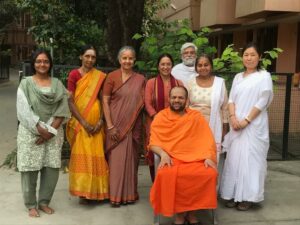Brahmasutra camp
 Swami Shivaprakashananda Saraswati conducted a vedantic camp at Rishikesh between 1 st and 15 th
Swami Shivaprakashananda Saraswati conducted a vedantic camp at Rishikesh between 1 st and 15 th
May 2019, where he took classes on Brahma Sutra, for students with exposure to Upanishads and
Bhashya in English.
Brahma Sutra, authored by Veda Vyasa, also called Badarayana Sutra or Sharirika Mimamsa, is a
part of Prastana Traya, along with Upanishads and Bhagavad Gita. This text is in the form of Sutra or
aphorisms. It consists of 555 sutras, organised into 4 adhyayas or chapters. Each adhyaya is further
divided into 4 padas or parts. The sutras in each pada are further grouped under adhikaranas or
topics. The text is primarily in the nature of deeper analysis of the Upanishadic statements, aimed at
resolving conflicts from other astika philosophies and establishing the purport of such statements as
per Advaita Vedanta sastra. Brahma Sutra being aphorism in its form, it is difficult for a vedantic
student to comprehend its purport as intended by the Sutrakara. Hence, it is always taught with
bhashya. While there were bhashyas prior to Jagadguru Sri Adi Sankaracharya’s bhashya, advaitic
study of Brahma Sutra is with Adi Sankaracharya’s bhashya, supplemented by Tikas as required. It is
important to mention that Adi Shankaracharya has even negated parts of bhashyas, written by his
predecessors.
Each Sutra has a sangati (connection with the previous sutra), vishaya (the purport of the sutra),
samshaya (doubt on the Upanishadic statement which is sought to be resolved), purvapaksha
(objections of sidhantins from other astika philosophies or that of sidhantha ekadesis) and sidhanta
(which negates the objections of the purvapaksha and establishes the purport of the sutra). These
five elements are outlined in a text called ‘Vaiyasika Nyaya Maala’, which is in the form of padaas or
set to metre.
Swami Shivaprakashanada followed a logical methodology wherein, he first explained the five
elements of the Sutra as per Vaiyasika Nyaya Maala, followed by listing the anuvrittis (those words
that come from other sutras into the sutra in reference). Thereafter he did Anvaya of the Sutra (to
explain the purport of the sutra) and explained the sutra. This was followed by an explanation of the
bhashya, which covered the purvapaksha, its negation and the establishment of the purport of the
sutra by the sidhanti. The teaching methodology adopted by Swami Shivaprakashananda was easy to
understand and was appreciated by all students.
In all, there were 58 classes, spread over 15 days, in which the Adhyasa Bhashya (the introductory
commentary), the first pada of the first Adhyaya (consisting of 11 Adhikaranas) and 4 adhikranas in
the 2nd pada (48 Sutras in total) were covered.
Swamiji connected the quotations from Upanishads underlying the sutras and the
Sutrabhashya with the Upanishad bhasyas that the students had already learnt. Doubts of students
were taken up and clarified by Swamiji either in the class or immediately thereafter, thereby
ensuring that the students benefitted from an exhaustive understanding of the text. Swamiji helped
students focus completely and easily on the subject by his immaculate style and helped students
understand the text, which is considered difficult.
The camp also had few late evening sessions where the students shared their understanding of the
classes amongst themselves.
Swamiji also took the students to a few ancient temples and ashrams in Rishikesh. Students look
forward to the next camp of Brahma Sutra !
Sri Gurubhyo namaha.
Comments are closed.